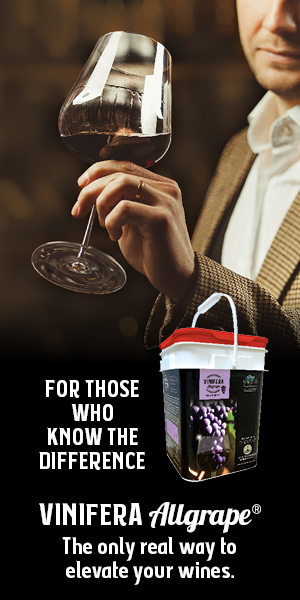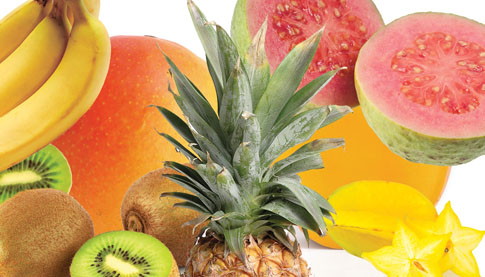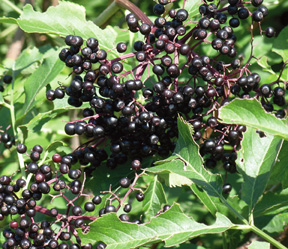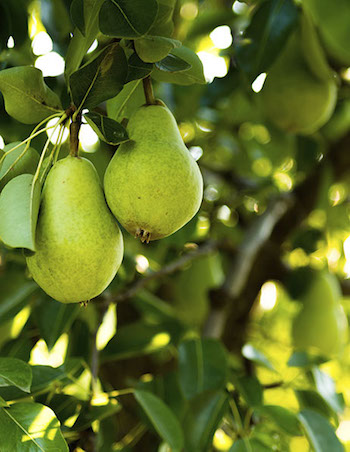 Countless friends and acquaintances grow their own fruit wines. Occasionally, they have a bumper crop or their freezer is full and they share. I personally currently grow pomegranates, navel oranges and am establishing a young Mission fig tree. Previous mature trees of Bartlett pear and Texas wild plums were lost to a blight (the perils of growing “organic”), but when they were producing they yielded about 300 pounds of pears (2 trees) and 125-150 pounds (57-68 kg) of plums (7 trees) annually. The great thing about all of these backyard fruit trees? You can make wine with the fruit!
Countless friends and acquaintances grow their own fruit wines. Occasionally, they have a bumper crop or their freezer is full and they share. I personally currently grow pomegranates, navel oranges and am establishing a young Mission fig tree. Previous mature trees of Bartlett pear and Texas wild plums were lost to a blight (the perils of growing “organic”), but when they were producing they yielded about 300 pounds of pears (2 trees) and 125-150 pounds (57-68 kg) of plums (7 trees) annually. The great thing about all of these backyard fruit trees? You can make wine with the fruit!
There is nowhere in North America or Europe below the Arctic Circle where suitable fruit trees cannot be grown. Even in Calgary (Alberta, Canada) there are at least 14 varieties of apple (more if we include crabapples), 3 varieties of apricot, 7 varieties of cherry, 6 varieties of plum, and 3 varieties of pear that grow well, all on appropriate rootstock. One must, however, be aware that some fruit require cross-pollination with different species, varieties, or cultivars to transition from flower to fruit. Any good nurseryman or agricultural agent can advise you on matches to satisfy this requirement.
The Reliables
Wherever you live, there are almost certainly dozens of fruit tree cultivars, either natural or specifically created through cross-breeding, that thrive in your location. It is not difficult to find them, but finding them is your first task. This can be as easy as doing a Google search. For example, the listing I mentioned for Calgary was obtained that way, provided by a nursery that specializes in plants reliably tolerant of Calgary’s climate and soils. The search for “fruit trees suitable for Calgary” returned 399,000 results. Study the varieties for your area and then visit a local nursery carrying only plants that do well in your locale. Talk to the most knowledgeable person there and pay particular attention to the most reliable performers.
Long ago I did a similar search for Pleasanton, Texas, where I live. By consulting perhaps 30-40 of the sites returned, a list exceeding 100 cultivars was obtained. At that time the area was serviced by a County Agricultural Extension Agent. By consulting with the Agent, the list was whittled down to about two dozen reliable cultivars. All the rest were based on test plantings that had not been established long enough to assign “reliable” to them or were based on anecdotal information that was never confirmed. Further, some cultivars had been developed for San Antonio, 30 miles to the north but with subtle yet important differences in soil pH and composition, rainfall and micro-climate variables. In other words, once you have a list of cultivars to work with, obtain a second or even third opinion from the most knowledgeable people you can find. These might include local nurserymen, university agricultural extension agents, and commercial growers.
Commercial orchard growers often have tried dozens of varieties and cultivars over an extended period and can report very detailed experience with successes and failures. Often cultivars not suitable to their needs will be very suitable to home planting. Some will flower at the wrong time, grow too vigorously or to the wrong size or shape for their needs, produce fruit too large or small or not suitable for their harvesting methods. The key factor is that it grows well in your area and reliably produces fruit.
Pollination
Pollination involves moving pollen from the flower’s anther to the stigma of the same or another flower. Movement of pollen is usually by wind, insects, or hummingbirds, but under rare circumstances might be by human intervention. Disregarding the latter, it is essential you know the pollination requirements of the specific cultivar you are going to plant. Generally, there are three possibilities:
• The tree is self-pollinating and can also pollinate identical trees. However, self-pollinating varieties usually set more fruit if cross-pollinated.
• The tree requires cross-pollination, meaning it requires pollen from a related but different variety.
• The tree is a seedless variety and produces fruit parthenocarpically — without pollen. If pollen from another tree is introduced, however, some seeds might develop.
To all three of the above there are exceptions. Apples, for example, require another pollinator from a different apple variety, but the pollinator can be an ornamental or fruiting crabapple. Two trees of the same cultivar will not work. With apples and most other fruit trees, the pollinator and pollen receptor should be within 100 meters of each other.
Some trees have finicky pollination requirements. Plums, for example, require cross-pollination to produce fruit and each variety requires specific pollinators. This is because European and Asian plums do not flower at the same time and so your varieties must be related. An exception is the Damson plum and one or two others, which are self-fertile. Your nursery (or Google) can help you here. If a neighbor has a plum tree, ask what variety it is and buy a tree that is pollen-compatible with it. Each yard in a neighborhood can successfully grow plums if they have compatible yet different varieties and bloom at the same time.
Now, on to the fruits! Here are three very common fruit trees that you can grow at home that also make great fruit wines.
Apples
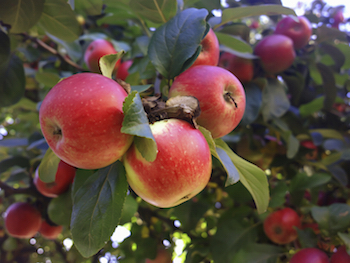 There are over 7,500 species, varieties, and cultivars of apple, one-third of which are grown in the United States but only 100 or so are grown commercially. Although grown commercially in only 36 states, some varieties are grown in all 50 states. Native to Central Asia and Eastern Europe, the apple has been widely transplanted to every continent except Antarctica. The North American native is the crabapple. Crossing the crabapple with the apple produced lineages that are responsible for most of the modern North American cultivars.
There are over 7,500 species, varieties, and cultivars of apple, one-third of which are grown in the United States but only 100 or so are grown commercially. Although grown commercially in only 36 states, some varieties are grown in all 50 states. Native to Central Asia and Eastern Europe, the apple has been widely transplanted to every continent except Antarctica. The North American native is the crabapple. Crossing the crabapple with the apple produced lineages that are responsible for most of the modern North American cultivars.
Almost all commercial apples are from grafts of successful cultivars onto rootstocks suitable for specific climates and soils as well as for specific size and vitality. Trees grown from apple seeds will grow into trees much larger than the tree the parent apple was harvested from. These trees will eventually yield far more apples than the grafted parent tree, but most of the apples will be too high for convenient harvest. When buying specific apple cultivars, with the possible exception of crabapples, you will almost certainly be buying cultivars grafted onto a rootstock. It is possible to graft several cultivars onto a single rootstock, each of which will produce its own variety and will cross pollinate.
Specific cultivars grafted to cold-hardy rootstock are grown in specific, favorable sites in Alaska and Canada. Trunks should be wrapped for at least the first three years from October into May to protect the cambium layer from thaw-freeze cycles. HGA-00038, published by University of Alaska Fairbanks and available online, should be consulted before planting.
Generally speaking, sweet apples make poor wine unless the wine is acidified to acceptable levels. Tart apples are preferred for wine, but the best wines (and hard ciders) are made from a mix of suitable tart and semi-tart to add to the wine’s complexity. The recipe at the end of this story assumes a mixture of varieties are crushed and fermented together.
Pears
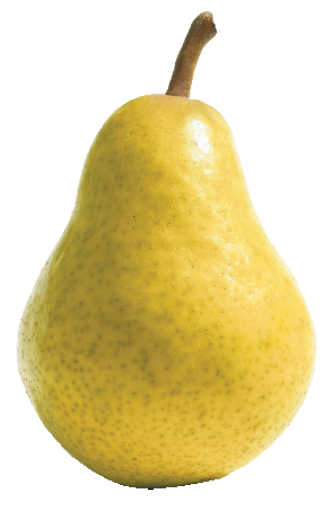 Believed native to Western China and spreading both north and south through Asia to Europe and North Africa, the pear has been cultivated in China for at least 3,000 years. There are at least 3,000 known varieties and cultivars of pear now spread over six continents with diverse cultural favorites. In the United States and Canada, some of a few dozen cultivars can be grown almost, but not quite, everywhere. Where conditions permit, they live long lives and can produce fruit for 50 years.
Believed native to Western China and spreading both north and south through Asia to Europe and North Africa, the pear has been cultivated in China for at least 3,000 years. There are at least 3,000 known varieties and cultivars of pear now spread over six continents with diverse cultural favorites. In the United States and Canada, some of a few dozen cultivars can be grown almost, but not quite, everywhere. Where conditions permit, they live long lives and can produce fruit for 50 years.
The humid Southeast and frigid North, despite rootstocks suited to both, are difficult regions for growing pears. There are varieties that grow well in the South if they are in full sun from sunrise until sunset, which dries the leaves and retards molds and fungus. These trees might live 10 to 25 years, but sooner or later they will succumb to fire blight unless blight resistant cultivars are selected. There are many varieties resistant to fire blight suitable for much of the South.
Rootstocks exist that will support grafted cultivars in the frigid North. However, although these will grow in Alaska for many years and flower, the growing season is simply too short except in the far south for fruit to develop. For the rest of the United States and Canada, many cultivars are widely grown. Some are self-fertile but set few fruit without another pollinator. Generally, pears require a pollinator and each variety has specific, compatible pollinators.
Pear trees also require a minimum number of chill hours, which for these and all trees with such a requirement are the number of hours at or below 45 °F (7 °C). Some popular varieties require 800 chill hours, but many require 500-600 hours. Some require as little as 200 chill hours and are suitable for the Deep South. Your local nursery can guide you in matching pollinators and chill hours.
Many people grow hard pears with coarse, sometimes gritty, flesh for baking, canning or wine, as they are generally unsuitable for eating fresh. While it may seem improbable, they do make good wine. However, sweet, juicy eating pears can be pressed separately and their juice added to the must. See a recipe for making fig wine at the end of this story.
Figs
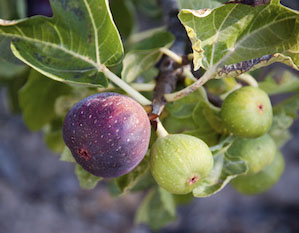 The fig tree (Ficus carica) is a species in the mulberry family and is native from Asiatic Turkey to Northern India. Archaeology has shown that figs were one of the earliest plants cultivated by humans and predates the domestication of wheat and rye by 1,000 years. In ancient times the fruit and trees were traded and grown by the Greeks, Phoenicians, Romans, and Carthaginians, thus spreading them throughout the Mediterranean and Black Seas. By the close of the 15th century fig trees had spread to Northern Europe and the New World. Today they grow in scattered areas throughout the temperate world.
The fig tree (Ficus carica) is a species in the mulberry family and is native from Asiatic Turkey to Northern India. Archaeology has shown that figs were one of the earliest plants cultivated by humans and predates the domestication of wheat and rye by 1,000 years. In ancient times the fruit and trees were traded and grown by the Greeks, Phoenicians, Romans, and Carthaginians, thus spreading them throughout the Mediterranean and Black Seas. By the close of the 15th century fig trees had spread to Northern Europe and the New World. Today they grow in scattered areas throughout the temperate world.
There are many hundred named varieties of fig (800–900 and still counting) and new varieties are released every year. The fruit of the fig tree are an inward growing flower enclosed by an external layer we think of as its skin or peel. The majority of fig flowers have a small opening at their apex to allow the entry and exit of the pollinator, which is a tiny wasp. Once the inverse flower is pollinated, the flower develops into a ripened fruit.
Of the many hundred varieties of fig, only a few are of interest to home gardeners for good reasons. There are essentially four types of fig trees. Caprifigs produce male flowers that never produce fruit. Smyrna figs produce female flowers that do not become fruit unless pollinated from a caprifig. San Pedro figs bear two fruitings a year. The first appears on leafless mature wood and requires no pollination, while the second appears on new wood and requires pollination from a male flower. The fourth are common figs, which are self-pollinating and may lack the apex opening that only exists to allow tiny wasps to enter, exit and transfer pollen or the apex opening is tiny and often closed by a resin.
There are dozens of varieties of common figs that are available regionally. It is best to research your specific area for the best-suited cultivars. Only buy from local nurseries that ensure they only sell locally- adapted plants.
While the fig grows and produces the best fruit in warm, dry temperate climates, with careful siting and well-drained soil they will grow well in wetter, colder areas. Truly dormant trees are hardy into the teens, with some varieties reportedly wintering to -17 °F (-27 °C). However, plants in active growth (bud break) can be damaged at 30 °F (-1 °C) so regional susceptibilities to early warming spells followed by late freezes are not ideal for fig trees. However, plants grown to a bush form are easier to protect from freeze than if grown to tree.
Because rains during fruit development and ripening can cause the fruit to split, planting on sloping land with good soil drainage is essential in wetter areas. A south or southwestern exposure favors quicker drying, which is hastened if the groundcover under the tree is rock or pebbles. Lastly, always plant figs in full sun.
In the US, fig trees grow from New York’s Long Island south through the coastal states to Mexico, across Texas to California and north to the Pacific Northwest. They are also grown in scattered microclimates suitable for them further inland or dwarf varieties in containers that can be protected from freeze or moved indoors. See a recipe for making fig wine at the end of this story.
Plums
Plums are a diverse subgenus related to peaches, cherries and other stone (pit) fruit. While only 40 or so species of plums are recognized, the number of cultivars is in the thousands. New World (native) plums, of which there are many, represent a section of the subgenus that is commercially unimportant but make excellent wine. Old World plums are either diploid (Asian in origin) or hexaploid (European in origin). But it is the Japanese plum (Prunus salicina) and its many hybrids and cultivars) that has gained worldwide prominence. The European plum (Prunus domestica) and its many hybrids and cultivars are dominant on that continent.
Plums offer a wide variety of cultivars, ranging in taste from tart to dessert sweet. They may be clinging (to the stone) or freestone. Some are ripe when picked while others continue to sweeten two to three weeks after harvest. Some have firm pulp while others are mouthwatering juicy. Some have mild flavor and others are rich and intense.
The vast majority of plums require specific pollinators but more and more cultivars have been developed that are self-fertile. However, even these will set more fruit if a compatible pollinator is nearby.
Plums differ widely in the number of winter chill hours required to awaken from dormancy. Using 45 °F (7 °C). or below, the majority of European plums require 800 hours but some require as little as 550. Japanese and Japanese-American hybrids generally require shorter chill hours, from 700 to as little as 250 hours.
Except for the extreme north and south of the US, there are dozens of native, Japanese, Japanese-American, European-American, and European plum varieties suitable for most locations. One must simply obtain the best recommendations for their area. Even with self-fertile varieties, it is recommended that two or more trees be planted relatively close together to encourage cross-pollination. Pollinators compatible with a neighbor’s trees still should not be single plantings, as better results and higher yields per tree will be enjoyed with two or more trees.
In Alaska and northern Canada, the Manchurian plum (P. salicina mandshurica) has been proven viable into zone 3, while the native American plum (P. americana) has proven to be a successful rootstock for Japanese-American hybrids into the same agricultural zone. However, only six varieties have proven hardy enough if planted in sheltered locations. However, they may or may not set fruit.
Plum wine was covered in “Stone Fruit Wines,” WineMaker issue Jun/Jul 2010.
Apricots
Apricots probably originated as recently as 3,000 years ago in the vicinity of the Russian-Chinese border, traveled the Silk Road through South-Central Asia into Europe, and are heavily naturalized along this route. Hundreds of varieties and cultivars exist and more are being developed all the time.
Absolutely delicious eaten ripe off the tree, apricots do not travel well and therefore we see many more sold dried than fresh. Those sold in supermarkets are usually less flavorful than those freshly picked. The good news is if you grow your own they don’t need to travel far to be eaten alone or in fruit salads, made into jams and preserves, baked into pies and tarts, integrated into Mediterranean dishes, or fermented into wine.
Apricots grow on full-size, semi-dwarf and dwarf trees. Full-size trees normally reach heights of 30 feet ( and breadths almost as great, but 45-foot heights are not unheard of. Semi-dwarfs are typically 15-25 feet high while true dwarfs can be grown in containers and still produce 1-2 bushels of fruit.
Being self-pollinating, apricots can be grown singularly but multiple trees benefit from cross-pollination. Selected natural varieties and their cultivars can be grown from USDA zones 9-5 and a very few can grow in zones 4-3, although the latter zone is more problematic. Because they flower early, a late frost can destroy the flowers or infant fruit.
Proper full-sun siting, possibly sheltered in the northern latitudes, and well- drained soil will usually support apricots. Since cold air flows downhill, planting on higher ground is advised. Soil pH of 6-7 is preferred but some tolerance either way will work. They put out extensive root systems, growing outward annually, and have been known to produce fruit for 75 years.
Apricots have naturally crossed with plums for centuries, but in the early 20th century Luther Burbank began a scientific breeding program and produced a number of hybrids he named plumcots. Although 50% apricot and 50% plum, some of their offspring tended to favor one parent or the other, offering distinctly different flavors. In the late 20th century new hybrids were introduced. The aprium is 75% apricot and 25% plum, while the pluot is 75% plum and 25% apricot.
Like most fruit trees, apricot varieties and their hybrids have specific chill hour requirements, ranging from 800 all the way down to less than 300 chill hours. With hundreds of cultivars available, it takes only a little research to narrow the list. Consultation with your local nursery that provides only area-friendly plants
Apricot wine was covered in “Stone Fruit Wines,” WineMaker issue Jun/Jul 2010.
Peaches
Peaches originated in China and were cultivated at least 4,000 years ago and described in manuscripts as far back as 1,100 BC. They traveled to India and Western Asia as pits and brought to Europe by Alexander the Great after his conquest of Persia, circa 300 BC. The Spanish brought them to the New World in the 16th century, about 100 years before they were introduced to France and England.
Due to chill hour requirements of about 500 hours, peaches grow best in dry, temperate climates. Hardier cultivars can survive temperatures down to -22 °F (-30 °C). but bud kill occurs between 5 and -15 °F (-20 and -26 °C), depending on the cultivar and how late the sub-freeze occurs. Cultivars have been developed for the Southeast, which require fewer chill hours and tolerate greater summer heat. As a whole and with hundreds of cultivars to select from, there are some cultivars suitable for much of the United States.
Peach trees normally survive 15-18 years in optimal growing areas and as few as seven years at the climatic extremes. Appropriate rootstock selection in extreme climates is essential. They prefer well drained sandy loam or loam with a pH range of 6.5 to 7 and require nitrogen supplementation. Soils outside this range must be modified for healthy, fruitful trees. They require full sun throughout the day. Dwarf varieties are available.
Nectarines, while treated in marketing as a separate fruit, are actually smooth-skinned peaches derived from fruiting sport growth. Nectarines tend to be slightly sweeter than the peaches on the tree the nectarines originally share. Nectarines are perceived as having harder, denser flesh than peaches, but this is because they are typically eaten before allowing them to fully ripen.
Peaches and nectarines are classified as freestone, cling and semi-cling, referring to whether the flesh clings to the stone (pit) or separates from it when cut. Flesh may be white, yellow or yellow streaked with red radiating from the stone outward. White fleshed peaches are sweeter, creamier and less acidic. Yellow fleshed peaches are generally more acidic, which tends to buffer their sweetness to a degree. White flesh peaches generally have white skin while yellow flesh peaches have yellow to golden skin. Both often have partial redness where exposed to direct sunlight. All varieties can be made into wonderful wine when supplemented with appropriate sugar, acid, tannin, and nutrients.
Making peach wine was covered in “Stone Fruit Wines,” WineMaker issue Jun/Jul 2010.
Recipes
Apple Wine (Yield 1 gallon/3.8 L)
Ingredients
24 lbs. (11 kg) apples, mixed varieties
2 lbs. (~1 kg) granulated white sugar
1 pint (~0.5 L) water
1 finely crushed and dissolved Campden tablet
1.5 tsp. pectic enzyme
1 tsp. yeast nutrient
1 packet Sauterne or Champagne wine yeast
Step by Step
Chop the apples into small pieces or crush, put into primary, add the water and Campden, stir, and cover the primary. Wait eight hours, stir in the pectic enzyme and nutrient and cover the primary. Wait another eight hours and add the activated yeast in a starter solution. The water will not cover the apples so stir at least twice daily to bring bottom apples to the top. Keep covered in a warm place for three days, stirring at least twice daily. Transfer apple pulp to a nylon mesh bag, press the juice from the pulp, return the juice to primary and stir in sugar until dissolved. When the vigorous fermentation subsides (3-4 days), transfer into a 1-gallon (3.8-L) secondary and seal with an airlock. Rack when clear, allow another 60 days, then rack again, stabilize* and bottle 30 days later if no renewed fermentation appears. Allow six months before tasting, one year for best results.
*For this and all subsequent recipes, stabilize means adding 0.5 tsp. potassium sorbate and 1 finely crushed and dissolved Campden tablet.
Pear Wine (Yield 1 gallon/3.8 L)
This recipe should be tweaked according to the variety, something you learn from experience. The only reliable way to determine how much water you will need is to destem, wash, quarter lengthways, remove all seeds, chop, place in nylon straining bag, crush, and press 4 pounds (1.8 kg) of pears, adding a pinch of powdered ascorbic acid to the juice to prevent browning. Measure the juice and multiply by 1.5 if using 6 pounds (2.7 kg), 2 if using 8 (3.6 kg), 2.5 if using 10 (4.5 kg), and 3 if using 12 (5.4 kg). Subtract this number from 1 gallon (3.8 L) and from that number subtract 11 fluid ounces (for the white grape concentrate) to yield the amount of water needed.
Ingredients
6-12 lbs. (3-5 kg) pears
1 can 100% White grape juice frozen concentrate
1.66 lbs. (0.75 kg) granulated sugar (for 6 lbs./2.7 kg pears), 1.33 lbs. (0.6 kg) sugar (for 12 lbs./5.4 kg) pears)
Water as calculated per above (to yield 1 gallon/3.8 L liquid after pressing
1.5 tsp. acid blend (for 6 lbs./2.7 kg pears), 3 tsp. acid blend (for 12 lbs./5.4 kg pears)
0.5 tsp. powdered pectic enzyme (for 6 lbs./2.7 kg pears), 1 tsp. powdered pectic enzyme (for 12 lbs./5.4 kg pears)
0.25 tsp. ascorbic acid
0.125 tsp. grape tannin (for 6 lbs./2.7 kg pears), 0.25 tsp. grape tannin (for 12 lbs./5.4 kg pears)
1 finely crushed and dissolved Campden tablet
1 tsp. yeast nutrient
1 packet Champagne active dry yeast (in starter solution)
0.5 Cup Grade A, absolutely clear honey for final sweetening
Step by Step
Put water on to boil, remove from heat and dissolve the sugar. Meanwhile, destem, wash and quarter the pears lengthways, remove all seeds, chop, place in nylon straining bag, tie bag, place in primary, and crush. Pour boiling water over the pears and cover primary. Wait one hour and add ascorbic acid, Campden tablet, acid blend, tannin and yeast nutrient. Cover the primary. Wait eight hours, add pectic enzyme and cover primary. Wait eight more hours and stir in the thawed grape concentrate. Take and record hydrometer reading. Gently pour yeast starter solution into the liquid (push the pears aside). Do not stir, so yeast are near the surface. Release the bag, which forces the yeast to follow liquid around the bag. Cover primary with cloth to allow yeast access to fresh oxygen. Several times daily (at least twice) use a spoon to submerge the pears. After three days take another hydrometer reading and do so daily thereafter. When specific gravity reaches 1.010 remove the bag and allow to drip drain for 1 hour. Do not squeeze the bag or the wine will be difficult to clear. Return drippings to primary and discard pulp. Transfer liquid and lees to a secondary, topping up to within 1 inch (2.5 cm) of the top if necessary and attach an airlock. Fermentation should not be vigorous, but not complete. Rack after about 30 days and after 60 days, adding another finely crushed and dissolved Campden tablet. Rack again after 60 days if wine has not cleared. When clear, stabilize with 0.5 tsp. potassium sorbate and another finely crushed and dissolved Campden tablet. Stir in 0.5 cup of absolutely clear honey, reattach the airlock, and wait about 30 days. If no signs of fermentation occur, degas the wine if needed and/or rack off into bottles. Age at least three months, but six or nine months are better.
Fig Wine (Yield 1 gallon/3.8 L)
Ingredients
6-8 lbs. (3-4 kg) figs
3 qts. water
1.75 lbs. granulated sugar
3.5 tsp. acid blend
1 finely crushed and dissolved Campden tablet
0.25 tsp. grape tannin
1 tsp. yeast nutrient
1 packet Montrachet wine yeast
Step by Step
Wash the figs and remove the stems down to the flesh. Chop or mince the figs. Place in a large, finely woven nylon straining bag, tie the top, and put in a primary fermentation vessel. Stir in all other ingredients except the yeast. Check the specific gravity (should be 1.085 to 1.100; if not, add up to 0.5 cup more sugar, stirring very well before re-checking S.G.). Cover with cloth. Add activated yeast in starter solution after 12 hours and stir daily, pressing pulp lightly to aid extraction of juices. When liquor reaches 1.040 S.G., hang bag over bowl to drain, lightly pressing to aid extraction (do NOT force or you will cloud the liquor). After the pulp drains, transfer to secondary and discard pulp. Fit an airlock to secondary. Ferment to dryness (S.G. below 1.000, no positive pressure in airlock). Rack into clean secondary, top up to 1 gallon (3.8 L) and reattach airlock. Rack again in 2 months. Rack again when clear and bottle. This is a good dry wine. If you want it sweeter, stabilize after last racking, then add 0.5 cup of absolutely clear honey. Bottle. This wine can be consumed young (after 3 months in bottle), but will improve immensely with age.


